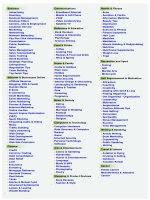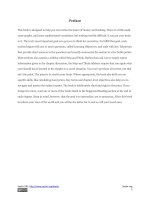Money and Banking: Lecture 6
Bạn đang xem bản rút gọn của tài liệu. Xem và tải ngay bản đầy đủ của tài liệu tại đây (332.13 KB, 15 trang )
Money and
Banking
Lecture 6
McGrawHill/Irwin
Copyright © 2006 by The McGrawHill Companies, Inc. All rights reserved.
Review of the Previous Lecture
• Financial Intermediaries
• Financial Instruments
• Uses
• Characteristics
• Value
3-2
Topics under Discussion
• Financial Instruments
• Examples
• Financial Markets
• Roles
• Structure
• Financial Institutions
3-3
Examples of Financial Instruments
Primarily Stores of Value
• Bank Loans
• a borrower obtains resources from a lender
immediately in exchange for a promised set of
payments in the future
• Bonds
• a form of a loan, whereby in exchange for
obtaining funds today a government or
corporation promises to make payments in the
future
3-4
Examples of Financial Instruments
Primarily Stores of Value
• Home Mortgages
• A loan that is used to purchase real estate.
• The real estate is collateral for the loan,
• it is a specific asset pledged by the borrower in order to
protect the interests of the lender in the event of
nonpayment.
• If payment is not made the lender can foreclose on the
property.
• Stocks
• an owner of a share owns a piece of the firm and is
entitled to part of its profits.
3-5
Examples of Financial Instruments
Primarily to transfer risk
• Insurance Contracts
• the primary purpose is to assure that payments will be made
under particular (and often rare) circumstances
• Futures Contracts
• an agreement to exchange a fixed quantity of a commodity,
such as wheat or corn, or an asset, such as a bond, at a
fixed price on a set future date.
• It is a derivative instrument since its value is based on the
price of some other asset.
• It is used to transfer the risk of price fluctuations from one
party to another
3-6
Examples of Financial Instruments
Primarily to transfer risk
• Options
• Derivative instruments whose prices are
based on the value of some underlying asset;
• They give the holder the right (but not the
obligation) to purchase a fixed quantity of the
underlying asset at a predetermined price at
any time during a specified period.
3-7
Financial Markets
• Financial Markets are the places where
financial instruments are bought and sold.
• Enable both firms and individuals to find
financing for their activities.
• Promote economic efficiency by ensuring that
resources are placed at the disposal of those
who can put them to best use.
• When they fail to function properly, resources
are no longer channeled to their best possible
use and the society suffers at large
3-8
Structure of Financial Markets
• Primary vs. Secondary Markets
• In a primary market a borrower obtains funds
from a lender by selling newly issued
securities.
• Most companies use an investment bank,
which will determine a price and then
purchase the company’s securities in
preparation for resale to clients; this is called
underwriting.
• In the secondary markets people can buy and
sell existing securities
3-9
Structure of Financial Markets
• Centralized Exchanges vs. Over-thecounter Markets.
• In the centralized exchange (e.g. Karachi
Stock Exchange www.kse.com.pk ), the
trading is done “on the floor”
• Over-the-counter (or OTC) market are
electronic networks of dealers who trade with
one another from wherever they are located
3-10
Structure of Financial Markets
• Debt and Equity vs. Derivative Markets
• Equity markets are the markets for stocks, which
are usually traded in the countries where the
companies are based.
• Debt instruments can be categorized as
• money market (maturity of less than one year)
or
• bond markets (maturity of more than one year
3-11
Financial Markets
Characteristics of a well-run financial market
1. Low transaction costs.
2. Information communicated must be accurate
and widely available
•
•
If not, the prices will not be correct
prices are the link between the financial markets
and the real economy
1. Investors must be protected.
•
A lack of proper safeguards dampens people’s
willingness to invest
3-12
Market Size and Investor Protection
3-13
Summary
• Financial Instruments
• Examples
• Financial Markets
• Roles
• Structure
3-14
Upcoming Topics
• Financial Institutions
• Time Value of Money
• Future value,
• Compound Interest
• Present Value
• Interest Rates
3-15









